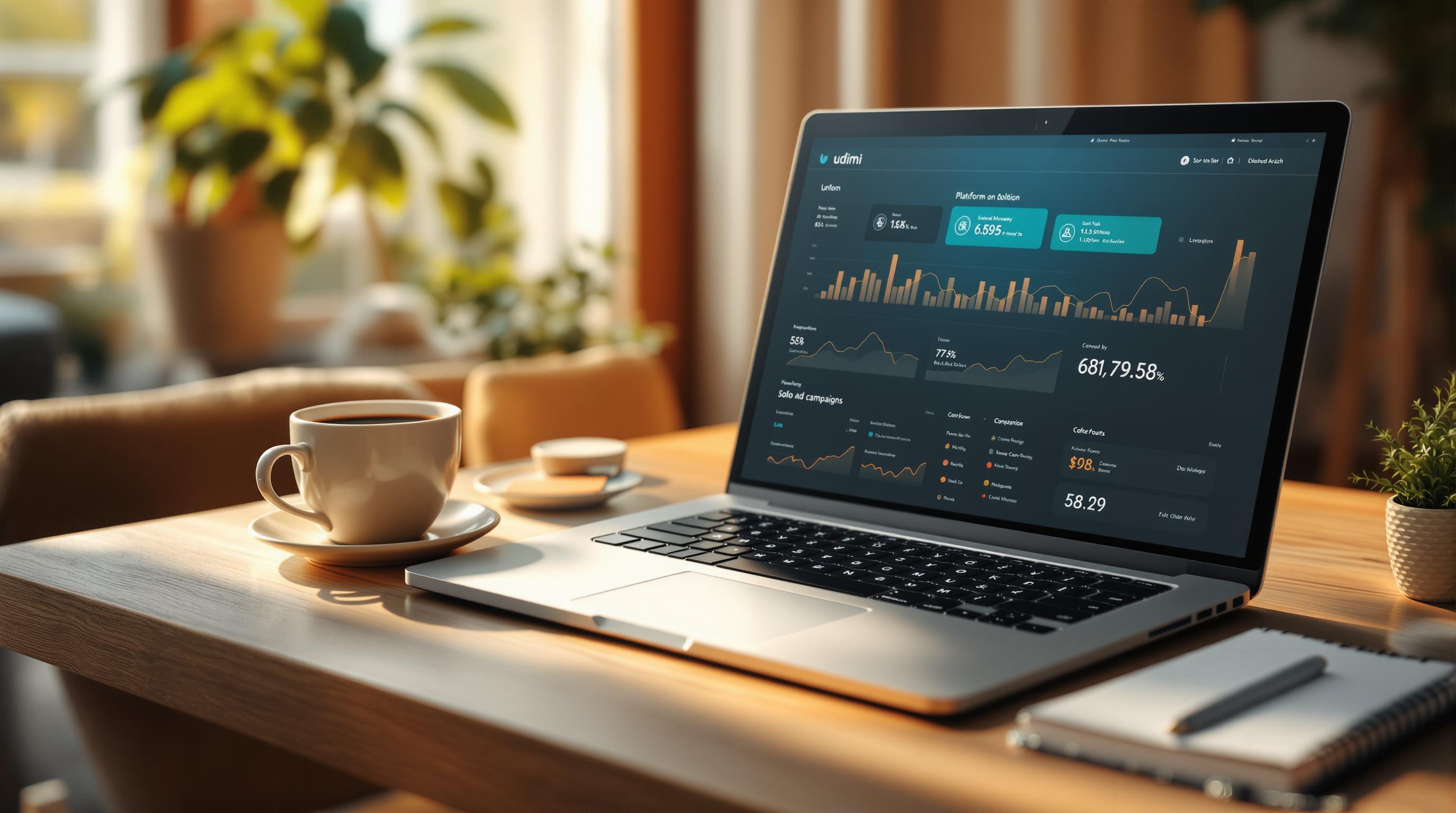Want to grow your email list or promote your offer quickly? Solo ads let you rent someone else’s email list to send your message directly to a targeted audience. They’re cost-effective, easy to track, and ideal for beginners. Here’s a quick overview of what you’ll learn:
- Find trustworthy solo ad providers to ensure quality traffic.
- Set clear goals using metrics like CTR, opt-in rate, and ROI.
- Write engaging emails with strong subject lines and CTAs.
- Track performance to optimize your campaign in real-time.
- Improve results with A/B testing and follow-up sequences.
- Scale successful campaigns for long-term growth.
Whether you’re aiming for leads, sales, or traffic, this guide breaks it down step-by-step so you can start small, test, and scale effectively.
Step 1: What Are Solo Ads?
Solo Ad Basics
Solo ads allow you to "rent" someone else's email list to promote your offer. Essentially, you pay to have your message sent as the only promotion to their subscribers. This ensures there are no competing offers distracting your audience.
Here’s how it works:
- Find a provider whose audience aligns with your niche.
- Write your email and set up a landing page.
- Pay based on clicks and monitor your results.
The cost typically ranges from $0.30 to $0.95 per click [4][5].
With this setup, understanding how to measure success is crucial.
Performance Metrics
When launching your first campaign, focus on these key metrics:
| Metric | Target Range | How to Calculate |
|---|---|---|
| Click-Through Rate (CTR) | 20-50% | (Clicks ÷ Emails Sent) × 100 |
| Conversion Rate | 1-5% | (Conversions ÷ Clicks) × 100 |
| Opt-in Rate | Varies by niche | (New Subscribers ÷ Clicks) × 100 |
| Cost Per Click (CPC) | $0.30-$0.95 | Total Cost ÷ Number of Clicks |
For example, if you purchase 200 clicks, receive 40 clicks, and generate 8 conversions, your CTR would be 20%, and your conversion rate would also be 20% [1][3].
Understanding these benchmarks helps you set clear goals for your campaign. Let’s move on to the next step.
Step 2: Set Your Campaign Goals
Write Clear Goals
Using the metrics from Step 1, define targets that match the purpose of your campaign. Clear, specific goals are essential for tracking your solo ad campaign's success. Avoid vague aims like "get more leads." Instead, focus on SMART goals - specific, measurable, achievable, relevant, and time-bound.
Here’s what a solid solo ad campaign goal should include:
- A measurable target (e.g., leads, sales, or visitors)
- A defined timeframe
- A maximum acceptable cost
- A clear way to track progress
For instance, a strong goal might be: "Gain 150 new email subscribers for our fitness newsletter within 7 days of launching the solo ad campaign, at a maximum cost of $2 per lead" [2].
Keep your focus on one main objective:
| Goal Type | Example Target | Common Metrics |
|---|---|---|
| Lead Generation | 200 new subscribers in 14 days | Opt-in rate, cost per lead |
| Direct Sales | $2,000 in product sales in 7 days | Conversion rate, ROI |
| Website Traffic | 1,000 landing page visitors in 10 days | Click-through rate, bounce rate |
Plan Your Budget
Your budget should reflect your goals and the returns you expect. If this is your first solo ad campaign, start small with a test budget of $100–200 [5]. This approach helps you gauge performance before committing more resources.
To calculate your budget, multiply your target conversions by (100 ÷ expected conversion rate) to determine the clicks needed. Then, multiply that by your maximum cost per click (CPC).
For example, if your goal is 100 new leads with a 25% conversion rate, you’ll need roughly 400 clicks. At this rate, an initial budget of $200 makes sense.
Don’t forget to include:
- Provider minimum spending requirements
- Costs for A/B testing
- Fees for tracking tools
With your goals and budget set, you’re ready to move on to evaluating providers - a key step in ensuring your campaign’s success.
How To Succeed with Email Marketing Using Solo Ads
Step 3: Pick the Right Provider
Now that you’ve set your goals and budget, it’s time to choose a solo ad provider. This decision plays a big role in how successful your campaign will be.
How to Choose a Provider
The provider you pick should align with your goals and budget from Step 2. Look for someone who offers the right audience size and pricing for your needs. Make sure they specialize in your niche and can deliver high-quality traffic.
What to Look For in a Quality List:
- Do they use clean practices like double opt-in and regular list maintenance?
- Can they provide verified audience data and engagement reports?
Here’s a quick comparison table to help you evaluate potential providers:
| Quality Factor | Good Signs | Red Flags |
|---|---|---|
| Pricing | $0.35-$0.95 per click | Under $0.30 per click |
| Minimum Order | 100-200 clicks | 1000+ clicks required |
| Support | Replies within 24 hours | No direct contact available |
| Tracking | Real-time stats provided | Limited or no reporting |
Recommended Solo Ad Platforms
To make things easier, here are some trusted platforms to consider:
Udimi
Rated 4.6/5, this platform offers advanced quality filters and direct access to sellers.
Traffic for Me
Known for niche targeting and strong customer support, this service is well-regarded on G2.
EzSoloAds
A marketplace with detailed seller performance history and real-time tracking options.
Red Flags to Avoid
Keep an eye out for these warning signs when assessing providers:
Pricing Problems:
- Hidden fees or vague pricing details
- Pushy sales tactics encouraging large upfront purchases
Quality Issues:
- No verifiable testimonials
- Weak or missing tracking systems
Before committing to a provider, test their service with a small order of 100-200 clicks. This helps you gauge their performance without taking on too much risk.
sbb-itb-aaea31d
Step 4: Write Your Email
Once you've chosen your provider, it's time to focus on creating emails that drive conversions.
Key Email Components
Every part of your email should align with the campaign goals you set in Step 2. Did you know that 47% of recipients open emails based solely on the subject line? [4]. Each element plays a role in boosting your click-through rate (CTR) and achieving your earlier targets.
| Component | Best Practice | Example |
|---|---|---|
| Subject Line | Keep it under 41 characters to avoid truncation | "24 Hours Left: 70% Off SEO Tools" |
| Preheader | Complement the subject line | "Exclusive offer for new subscribers - act fast!" |
| Opening Hook | Address a pain point or highlight a benefit | "Imagine mastering digital marketing in just 30 days" |
| Main Content | Offer a clear value proposition | "Our accelerated course condenses years of expertise into 4 weeks" |
| Call-to-Action | Use an action-oriented button | "Start My Free Trial" |
Engagement Tactics That Work
Adding a personal touch can increase click-through rates by 14% [6].
Ways to Boost Engagement:
- Create urgency: Time-sensitive offers work wonders. Try something like, "Only 10 spots left at this price!"
- Show social proof: Build trust by sharing real stats or testimonials. For example, "Join 50,000+ marketers who've increased leads by 300%."
- Highlight your CTA: Place your main call-to-action above the fold. Use contrasting colors to make it pop, and ensure the button is at least 44x44 pixels for easy tapping.
Make It Mobile-Friendly
With 40% of emails opened on mobile devices first [5], ensuring your email looks great on smaller screens is a must. Poorly rendered emails often lead to wasted clicks and lost opportunities.
Mobile Optimization Tips:
- Use responsive design for seamless viewing
- Set body text to 14px and headlines to 22px
- Keep paragraphs brief and easy to scan
- Test your email on multiple devices before hitting "send"
"Emails that display incorrectly on mobile are deleted by 70% of recipients within three seconds", according to Email on Acid's 2023 Mobile Email Engagement Study [3].
Step 5: Start and Watch Your Campaign
With your email content ready and your provider set up, it's time to launch your campaign. Here's how to make sure everything runs smoothly:
Pre-Launch Steps
Before hitting "send", double-check these critical areas:
| Check | Action | Purpose |
|---|---|---|
| Links & Analytics | Test all links and tracking codes | Prevents missed clicks and errors |
| Welcome Sequence | Confirm automation triggers and timing | Ensures smooth onboarding for subscribers |
| Provider Setup | Verify budget and payment details | Avoids overspending or billing issues |
Measure Your Results
Track your campaign's performance using tools like ClickMagick or Voluum [7]. Compare these results with the targets you set in Step 2 to identify any gaps:
- Opt-in rate
- Unsubscribe rate
- Return on investment (ROI)
Using third-party tools like ClickMagick can provide unbiased insights [6].
Make Quick Fixes
Monitor live metrics like click-through rates (CTR) and conversions to make immediate adjustments. If issues persist, revisit the criteria you used to select your provider in Step 3.
-
Low Click-Through Rates: If the first-day metrics are underwhelming, try:
- Tweaking subject lines
- Testing different preview text
-
High Bounce Rates: Use Google Analytics to evaluate your landing page. Focus on:
- Simplifying form fields
- Reducing complexity
-
Poor Conversion Rates: If conversions are below expectations, review:
- The clarity of your call-to-action (CTA)
- The appeal of your offer
Once you've addressed these immediate concerns, you're ready to dive into long-term analysis in Step 6.
Step 6: Review and Improve
Use the goals you set in Step 2 as reference points to evaluate and refine your solo ad campaign's performance.
Analyze Key Metrics
Compare your final results with the objectives from Step 2 to spot areas for improvement. Pay close attention to these metrics:
| Metric | Formula | Target Range |
|---|---|---|
| Click-Through Rate (CTR) | Clicks ÷ Recipients × 100 | 25-50% |
| Conversion Rate | Conversions ÷ Clicks × 100 | 1-5% |
| Cost Per Lead (CPL) | Total Cost ÷ Leads Generated | Depends on your budget |
| ROI | (Revenue - Cost) ÷ Cost × 100 | Aim for a positive percentage |
Experiment With Variations
Building on the adjustments made in Step 5, systematically test different elements to fine-tune your campaign:
- Subject lines: Try different tones or hooks.
- Email body length: Experiment with short and long formats.
- CTA placement and wording: Test various positions and phrases.
- Personalization techniques: Use names, locations, or other details.
For accurate insights, test each variation with at least 1,000 recipients.
Re-Engage Non-Buyers
Don’t lose touch with those who didn’t make a purchase. Create follow-up sequences aimed at re-engaging them:
- Segment your audience: Group them by how they interacted with your email.
- Send value-driven emails: Use templates from Step 4 to provide useful content.
- Offer time-sensitive deals: Encourage action with limited-time promotions.
Plan 3-5 follow-up emails over 14 days, tailoring each message based on how recipients respond.
Wrapping It Up
By following these six steps - from defining SMART goals to analyzing and improving performance - you can create a reliable process for running successful solo ad campaigns. Breaking it down step by step makes launching your first campaign much easier. Solo ads are still a fast way to connect with targeted audiences.
The key to success lies in executing each step carefully: learning the basics, setting clear objectives, picking trustworthy providers, writing engaging emails, tracking results, and refining your strategy. Use the performance metrics from Steps 5 and 6, along with the provider selection tips from Step 3, to build a system that consistently drives traffic.
Start small by testing with the budget plan outlined in Step 2. Once you identify what works, scale those campaigns. With this structured method, solo ads can become a dependable traffic channel.


